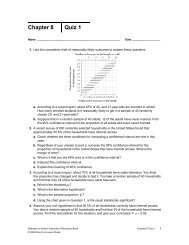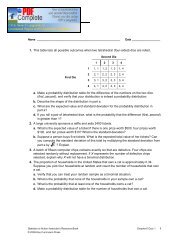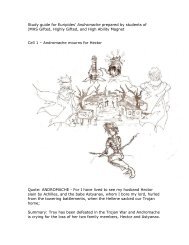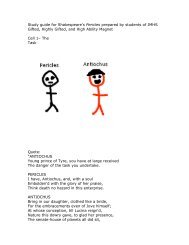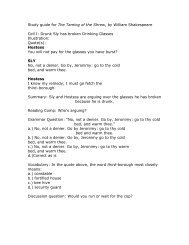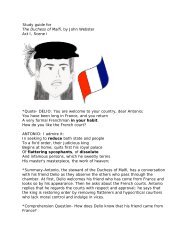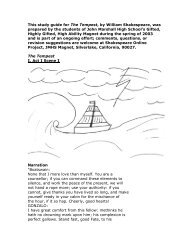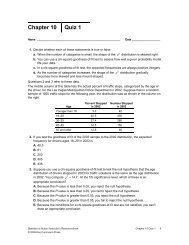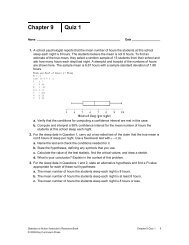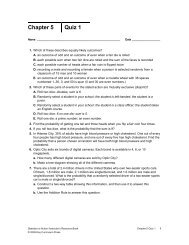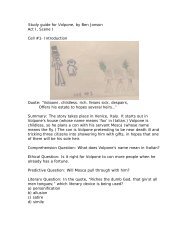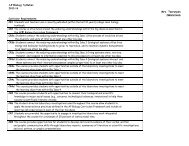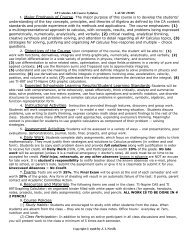Read This! - John Marshall High School
Read This! - John Marshall High School
Read This! - John Marshall High School
You also want an ePaper? Increase the reach of your titles
YUMPU automatically turns print PDFs into web optimized ePapers that Google loves.
Why?<br />
Cellular Respiration<br />
How is energy transferred and transformed in living systems?<br />
Living organisms display the property of metabolism, which is a general term to describe the processes<br />
carried out to acquire and use energy. We know that people need to eat, and in our foods are various kinds<br />
of nutrients that our cells use. One large group of nutrients in our foods is carbohydrates, which supply<br />
our cells with glucose (C 6 H 12 O 6 ). So the question is: How does the food we chew and swallow fuel our<br />
cells?<br />
Model 1 – Glycolysis<br />
ADP<br />
ADP<br />
NAD<br />
NAD<br />
1. Refer to Model 1.<br />
a. What is represented by the hexagon?<br />
Cell membrane<br />
! = pyruvic acid (3 C)<br />
= glucose (6 C)<br />
= mitochondrion<br />
= nucleus<br />
b. How many carbon atoms (C) are in one molecule of glucose?<br />
2. Refer to Model 1.<br />
a. What is represented by the triangles?<br />
b. How many carbon atoms (C) are in one molecule of pyruvic acid?<br />
3. In the process of glycolysis, what happens to glucose after it crosses the cell membrane into the<br />
cytoplasm of the cell?<br />
Cellular Respiration 1<br />
ATP<br />
ATP<br />
NADH<br />
NADH
<strong>Read</strong> <strong>This</strong>!<br />
Glycolysis occurs in the cytoplasm of cells and does not require the presence of oxygen. Therefore, the<br />
process is anaerobic. It is the fi rst step used by cells to extract energy from glucose in the form of ATP.<br />
ATP can be directly used by cells.<br />
4. Thinking about the number of carbon atoms in glucose and in pyruvic acid, explain why there<br />
is one molecule of glucose on the left side of the arrow and two molecules of pyruvic acid on the<br />
right side of the arrow.<br />
5. How many ATP molecules are produced during glycolysis?<br />
6. Hydrogen-carrying molecules are also produced during glycolysis. What is the symbol of these<br />
hydrogen-carrying molecules?<br />
7. Does glycolysis occur inside or outside the mitochondria?<br />
Model 2 – Krebs Cycle<br />
Mitochondrial matrix<br />
NAD +<br />
Outer mitochondrial<br />
membrane<br />
NAD +<br />
NAD + NAD +<br />
FAD<br />
ADP<br />
Inner<br />
mitochondrial<br />
membrane<br />
= pyruvic acid (3 C)<br />
= carbon dioxide (1 C)<br />
2 POGIL Activities for <strong>High</strong> <strong>School</strong> Biology<br />
NADH<br />
NADH<br />
NADH<br />
NADH<br />
8. According to Model 2, what happens to pyruvic acid during the Krebs cycle?<br />
FADH 2<br />
9. According to Model 2, where does the change identifi ed in the previous question occur?<br />
ATP
10. Note the number of atoms of carbon in pyruvic acid and explain why three molecules of carbon<br />
dioxide are produced.<br />
11. Considering that glycolysis produces two pyruvic acid molecules per glucose molecule, how<br />
many total CO 2 molecules will be produced from the complete breakdown of each glucose<br />
molecule? Show a mathematical equation to support your answer.<br />
12. What two hydrogen-carrying molecules are formed during the Krebs cycle?<br />
13. Fill out the chart by looking back at the entire process of glycolysis and the Krebs cycle to list the<br />
total number of ATPs and hydrogen-carrying molecules produced.<br />
Process ATP NADH FADH 2<br />
Glycolysis<br />
Krebs cycle<br />
(1st pyruvic acid)<br />
Krebs cycle<br />
(2nd pyruvic acid)<br />
Cellular Respiration 3
Model 3 – The Electron Transport Chain<br />
Mitochondrial<br />
matrix<br />
Outer mitochondrial<br />
membrane<br />
Inner mitochondrial<br />
membrane<br />
e –<br />
NADH<br />
H +<br />
NAD +<br />
H +<br />
FADH 2<br />
4 POGIL Activities for <strong>High</strong> <strong>School</strong> Biology<br />
FAD<br />
H +<br />
e –<br />
ADP ATP<br />
14. What cell structure is the site for the electron transport chain?<br />
H +<br />
H 2O<br />
e – = electron<br />
= oxygen<br />
15. Label the carrier proteins in Model 3.<br />
16. What substance do the carrier proteins transport across the inner mitochondrial membrane?<br />
<strong>Read</strong> <strong>This</strong>!<br />
NADH and FADH 2 molecules release hydrogen ions that are transported across the inner mitochondrial<br />
membrane with the help of electrons. The result of these multiple processes is the production of large<br />
amounts of ATP.<br />
17. What high energy molecules are formed by the electron transport chain?<br />
18. Refer to Model 3.<br />
a. What atom accepts the hydrogen ion at the end of the electron transport chain?<br />
b. What molecule is formed as a product of that acceptance?<br />
19. Formulate an explanation for why the events of the electron transport chain constitute an aerobic<br />
process rather than an anaerobic process (like glycolysis).
<strong>Read</strong> <strong>This</strong>!<br />
Remember that glycolysis produces two pyruvic acid molecules per glucose molecule along with two of<br />
the hydrogen-carrying NADH molecules. Remember also that the Krebs cycle produces NADH as well as<br />
another hydrogen carrier called FADH 2 . It is important to know that during the electron transport chain,<br />
when each NADH gives up electrons and hydrogen ions, there is enough of a potential energy change to<br />
make three ATP molecules. When each FADH 2 gives up electrons and hydrogen ions, there is enough of a<br />
potential energy change to make two ATP molecules.<br />
20. Fill in the chart below to calculate the total amount of ATP produced from the breakdown of<br />
each glucose molecule during the three steps of cellular respiration.<br />
Glycolysis<br />
Krebs Cycle<br />
Electron Transport Chain<br />
Total ATP Produced<br />
Number of ATP produced<br />
from one glucose molecule<br />
_______________<br />
Grand Total ATP produced (add all 3 columns above)<br />
Number of H-carriers produced<br />
from one glucose molecule<br />
NADH FADH 2<br />
x 3 x 2<br />
21. Look at the equation for cellular respiration and write in which stage of the process each molecule<br />
is either used or produced.<br />
C H O 6 12 6 + 6O2 → 6CO2 + 6H O 2 + 38 ATP<br />
Used in Used in Produced in Produced in Produced in<br />
22. Compare the ATP available to cells when oxygen is present versus when it is absent. How might<br />
this help explain why brain and heart functions are so quickly affected when a person cannot<br />
breathe?<br />
Cellular Respiration 5
Extension Questions<br />
Model 4 – Two Kinds of Anaerobic Respiration<br />
glucose<br />
Fermentation (no O 2 present in cell) OR<br />
glucose<br />
pyruvic<br />
acid<br />
pyruvic<br />
acid<br />
6 POGIL Activities for <strong>High</strong> <strong>School</strong> Biology<br />
lactic<br />
acid<br />
alcohol +<br />
CO2<br />
23. What are the two substances that may be formed in anaerobic respiration?<br />
24. Recall that two molecules of ATP are formed during glycolysis. Neither fermentation process<br />
shown above creates any more ATP. Knowing this, what would you predict about the cellular<br />
energy available to organisms that carry out fermentation?<br />
25. Research the relationship between overexertion of muscles and the formation of lactic acid. How<br />
does this relate to “the burn” felt during strenuous activity?<br />
26. What common foods involve the process of fermentation? Use your textbook or other resource to<br />
make a list of the foods and the specific organisms used.



